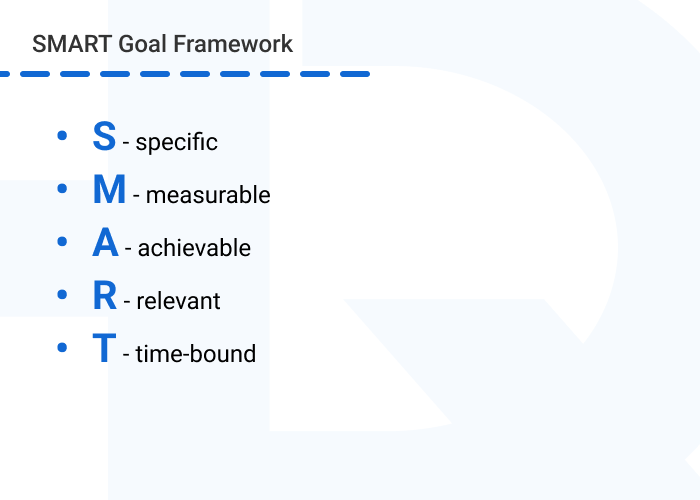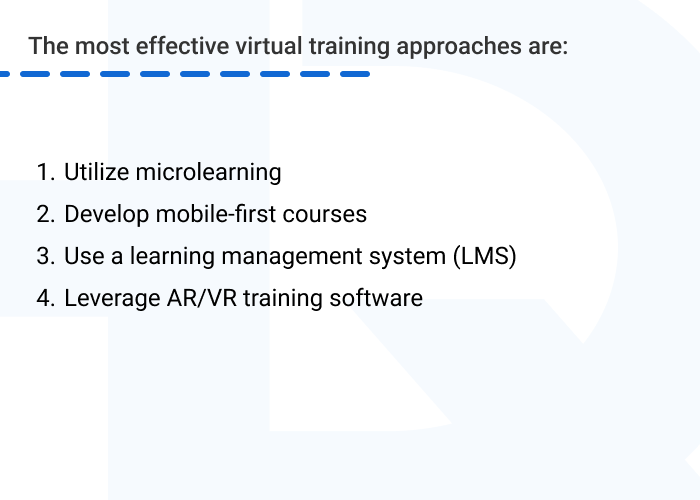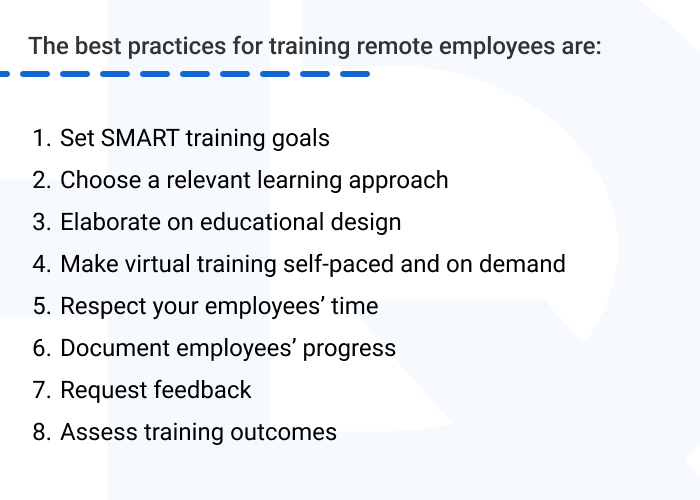Choose a Relevant Learning Approach
Elaborate on Educational Design
Based on the findings of EY’s Future Workplace Index, around 72% of companies have implemented a hybrid work model, with approximately 20% embracing fully remote work. However, training employees who are not co-located can pose unique challenges, such as delivering an equal quality of training, ensuring real-time collaboration, and more. Here is where e-learning techniques, such as LMS, AR and VR employee training, or microlearning, can help.
Our expertise in developing educational software, as well as our ability to create interactive content design from scratch, has helped us define 8 virtual-training best practices to ensure employees based anywhere can enjoy engaging learning experiences.
Choose a Relevant Learning Approach
Elaborate on Educational Design
The essential first step in establishing clear goals for effective remote employee training is to identify what training is needed and how you will evaluate your employees’ progress. Based on the estimated resources needed, you can set up precise budgeting for your future training program.
To help with goal-setting and create efficient online training for remote jobs, you can employ the SMART framework’s five criteria:

This useful framework lays the foundation for a successful remote learning experience and helps you select the proper learning approach.
The learning approach forms the backbone of learning sessions, impacting the level of content organization, learner tracking, collaboration, and support.
Choosing the appropriate training approach and utilizing modern systems can enhance engagement by offering convenient access to materials and interactive learning methods. You can also optimize learning outcomes through timely content updates and improve ROI by effectively tracking the performance of remote workers.
Below, we’ve compiled the most effective virtual training approaches to select, so your employees can focus maximum time and effort on the learning process.

Microlearning involves delivering content in short, bite-sized sessions of 5-10 minutes that can be easily completed during small breaks in the day. This might include a short video, interactive module, or one-page guide focusing on one main topic.
For remote learners with busy schedules, microlearning promotes memorization of material out of long lessons. By systematically unlocking the new task content at any convenient time, employees feel a sense of progress and accomplishment, which further motivates them to continue their learning journey.
Microlearning is especially effective for onboarding new remote hires and updating knowledge on constantly changing policies or systems.
Mobile-first courses cater to the on-the-go nature of remote employee training, enabling learners to engage with training materials wherever it suits them best. Whether workers are on their way to work, working from home, or in between tasks, they can easily access training materials from their smartphones or tablets, eliminating barriers of time and location.
Employees can access mobile-first courses in an offline mode. This feature is valuable for international employees who may have intermittent or limited internet connectivity. They can download course content in advance and access it even while offline, ensuring uninterrupted learning experiences.
LMS is a centralized hub for hosting all training content, tracking employee progress, facilitating live sessions, and automating administrative tasks. Through the LMS, trainers can upload learning materials, including multimedia content, documents and case studies relevant to remote employees’ work, and set up online sessions.
In addition to facilitating real-time support for remote learners, communication tools such as forums or chats enable trainees to ask questions and receive timely responses.
To gain insights into the performance metrics of each employee, you can incorporate assessments functionality. This not only helps to identify knowledge gaps but also addresses them by consistently offering refresher courses tailored to performance metrics.
At HQSoftware, we can develop an LMS to help you store and manage educational content, information about students, and improve learning outcomes.
For instance, we have created an e-learning platform that enables users to efficiently train employees regardless of the distance. The solution can also track learners’ progress and key performance indicators across multiple devices.
The system features two key operational modes: content generation and performance assessment. The platform enables the creation of training materials based on performance measurements, facilitates performance observation, and supports the improvement of training materials through feedback on learning progress.
If you want to learn how to empower your remote employee training with highly engaging and high-impact features, you can read here about our services in developing LMS solutions.
Simple off-the-shelf e-learning solutions may not be enough for companies dealing with complex manufacturing, healthcare, or hazardous settings.
In such cases, the interactive nature of VR and AR uniquely enhances learning comprehension for remote employees across a wide variety of topics:
Compared to traditional online training courses, customized solutions supplied via AR/VR offer a more efficient training experience. However, regardless of the learning approach, the training falls short without a proper educational design.
Want to create an AR/VR solution for employee training?! We’re ready to help!HQSoftware has a team of skilled professionals ready to tackle the project. Ask me!
Anna Halias
Business Development Manager
As experts in creating educational design from scratch, we can suggest some useful practices you can employ to create effective educational materials:
A robust educational design involves strategic planning, but it sets the stage for an effective remote training experience. So, choosing a reliable e-learning software provider is perhaps one of the most important stages when developing remote employee training.
Andrey Kazakevich
Head of Production
at HQSoftwareTraining can be more effective if it is developed with professional educational materials, empowering both organizations and employees to navigate the path of learning.
Whether starting from scratch or enhancing what’s in place, our educational design expert can create optimal training experiences that will strengthen learning outcomes.
Self-paced virtual learning respects the constraints of remote distributed teams, allowing them to learn independently. Clear instructions and guidelines ensure they have everything they need to complete the remote employee training successfully. Below are some effective approaches that help in managing remote employee training:
By being given personalized learning paths, employees can concentrate on areas they truly need to perform their jobs.
If you prioritize the most critical skills that your employees need to acquire, you can avoid overwhelming them with unnecessary content, ultimately saving on your training budget. Here some useful tips for providing autonomy while keeping learners motivated:
How do modern businesses use AR to increase their revenues and outperform their industry competitors?

To ensure employees stay on track with their milestones, you’ll need to incorporate reporting mechanisms. By documenting employees’ progress, you can track completion of courses, modules, assessments, and time spent on activities.
For instance, VR training solutions offer efficient tools for learners’ performance and progress tracking. One of the tools available is xAPI, a learning specification that enables you to collect data on how students learn.
Using xAPI, businesses can track student performance, identify which parts of the program require more or less time for comprehension, analyze how students interact with educational content, etc.
Having access to this data enables you to conduct robust analytics on learning efficiency, automate reporting processes, and collect necessary data to enhance VR training.
One of the keys to successful remote employee training is to collect feedback from your staff on the training process. Here are some of the most efficient approaches for review collecting:
Once you have gathered valuable information regarding the gaps or milestones achieved in your remote employee training, you can proceed with a thorough analysis.
Specific, well-defined goals allow for effective evaluation of online training for remote jobs. Key parameters that can be tracked include completion rates, assessment scores, and time taken to complete milestones.
Comparing these metrics to a goal developed within a SMART framework sets a benchmark for success. Let’s consider an example.
If the objective was to train 80% of sales staff on a new product launch within 2 months, tracking the number of salespeople who finish the course and pass the certification test within the deadline clearly shows whether the goal was met. Any deviations from the set targets can help identify specific areas for further attention.
Overall, by following these strategies focused on communication, content delivery, and participation monitoring, you can establish strong remote training practices.

An employee-centric approach to virtual training provides the best means of developing skills regardless of location. By implementing the virtual-training best practices we have mentioned in this article, you can support your employees’ professional growth.
By moving to a digital training approach, you will be able to:
Thanks to our experience in developing e-learning solutions across various industries, we have the expertise to create a seamlessly integrated, flexible, and user-friendly e-learning system. Our approach includes creating educational content from scratch or redesigning your current one, incorporating responsive design elements, and implementing localization features. We also ensure that your e-learning system can seamlessly connect with third-party solutions when needed.
Contact us to learn more about e-learning development services.

Educational Design Lead
A professional with over 20 years of experience in sales, marketing, and management across diverse industries, including education and consulting services. Adept at developing new educational products and services.
We are open to seeing your business needs and determining the best solution. Complete this form, and receive a free personalized proposal from your dedicated manager.

Sergei Vardomatski
Founder